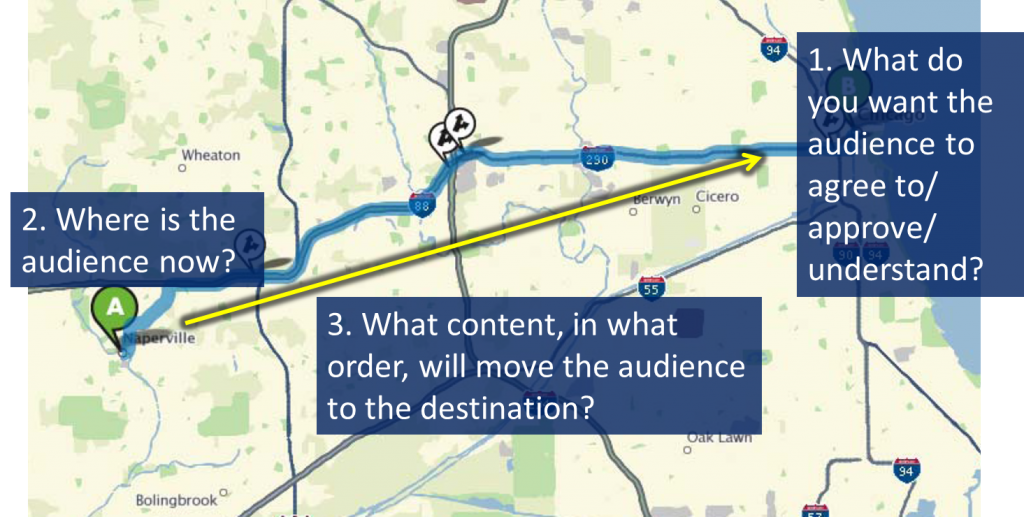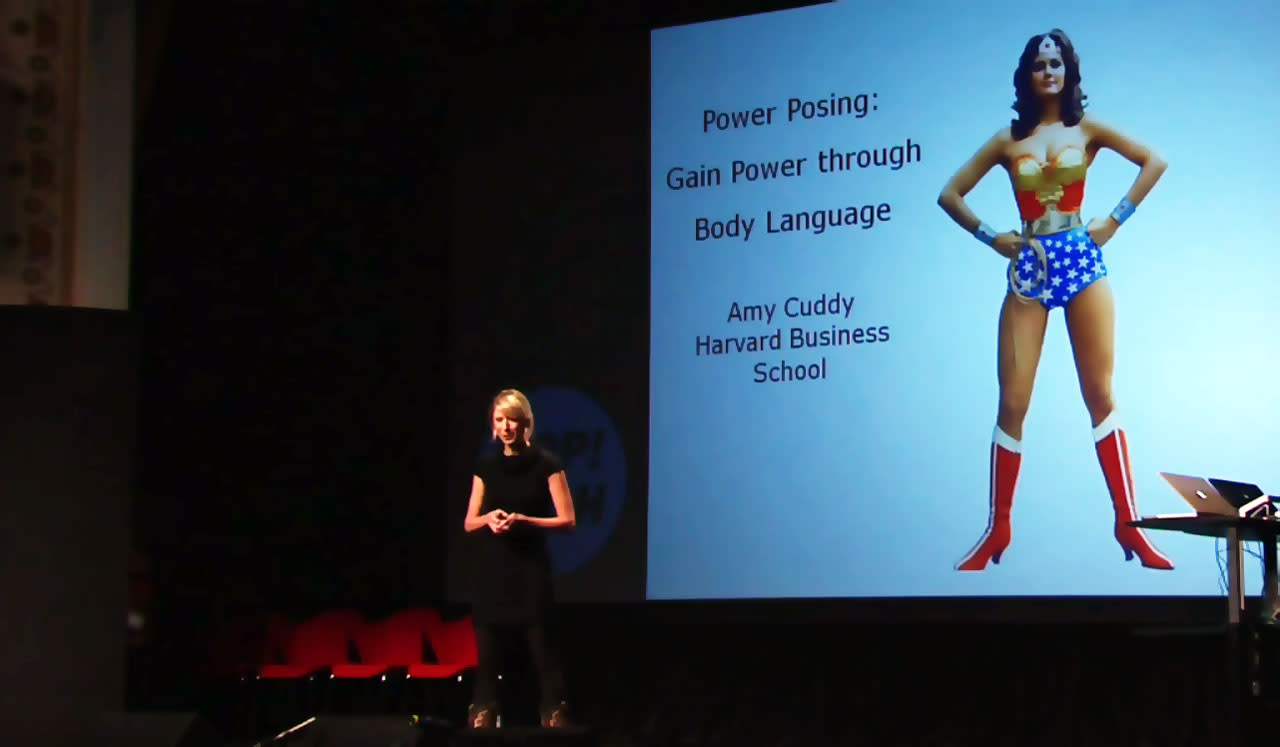I once rapped Biz Markie's "Just a Friend" in front of a 300-plus person audience.
The occasion: I was in charge of the personal training department on our college campus, and I needed a way to introduce our program during an all-staff meeting. I was searching for a fresh, funny way to kick things off—and after jotting down a few shaky rhymes, I figured out that writing my own rap was going to be tough.
I was still polishing my lyrics late the night before, and I could only fit in one run-through before stepping on stage.
Some say public speaking is like standing on stage in your underwear. I felt like I was naked, plus my hair was on fire.
After five years, I have yet to perform another public rap. But I have improved my public speaking skills by emulating engaging speakers. Whether it's a pitch at work or a TEDx talk, these strategies will take your presentation game to the next level.
1. Brainstorm Your Topic

The most difficult part of giving a talk is pinpointing an idea or a message. Here's how you can cruise through the brainstorming stage.
Don't Wait Until You're an Expert
My biggest fear about getting on stage has nothing to do with me. It has to do with the audience. What if someone in the audience is an expert on the particular topic I choose, and I make a mistake?
If everyone waited until they were an expert on a subject matter to get on stage, there would be very few people available for presentations. You don't have to be an expert at all. According to Zach Holman, author of the speaking advice site Speaking.io, presenters have two main qualities:
They’ve done this particular something a lot
They want to talk about it
Holman admits that getting beginners on stage can be beneficial, even for experts. "I’ve also listened to beginners talk about subject matter that I knew very well," he says, "but it was still interesting to me because it made me rethink with fresh eyes something that I had thought I had known all about."
Here are questions to get you started:
What are one or two uncommon things that you do on a daily basis, which everyone else should also consider doing?
During the past one or two years, which skills have you improved at the most?
What is one skill you have taught someone during the past year that could also be beneficial to someone else?
Keep it Small
If you're giving a talk on inspiring musicians, your initial inclination is to cover everyone from the past 200 years. That's a mistake.
Trying to include every single detail in a presentation is overwhelming for both the speaker and the audience. Chris Anderson, curator of TED, says that this is the number one mistake he sees in presentation drafts.
"You can’t summarize an entire career in a single talk. If you try to cram in everything you know, you won’t have time to include key details, and your talk will disappear into abstract language that may make sense if your listeners are familiar with the subject matter but will be completely opaque if they’re new to it."
Instead, focus on a very specific subject matter. Rather than giving a presentation on writing (vague) consider limiting your scope to tips for mastering first drafts (specific).
2. Build Your Slide Deck

Even if you consider yourself an expert in your chosen topic, you can't deliver eloquent prose off-the-cuff. You need to iron out the kinks in your message first. Here are some tips for turning your ideas into slides.
Type Out Your Talk
It's tempting to hop right into PowerPoint and start building your deck. Without a proper outline in place, you'll end up frustrated and disorganized. I've found it helpful to start with three questions:
Who is my audience?
If they walk away remembering only one thing, what do I want it to be?
What are 3-5 points that help to convey that idea?
With those three questions, I have the skeleton of my talk fleshed out. Mike Knoop, co-founder of Zapier, uses an outline format to structure his talks, too. He begins by coming up with top-level categories he wants to hit during his presentation. Eventually, he transforms each top-level category into three full sentences:
"For each top-level category I like to have (at least) three sentences: one for the introduction, one for the meat, and one for the transition to the next top-level category. You'll use these sentences as waypoints (and can even read verbatim while practicing...)."
Whichever method you choose, the key is to get your ideas down on paper.
Pretend Your Presentation is a Trip
Dave Paradi from ThinkOutsideTheSlide.com provides one of the most helpful analogies for planning a presentation: Pretend that it's a trip, and that your slides are the GPS.

For example, say you’re pitching the higher-ups on why they should create a new branch of the company. The first marker on your "trip" is actually the destination - what you want the audience to agree with you on?
Next, plot your audience's current location—what do they think right now? Are there certain opposing arguments you know you’ll have to overcome? What hurdles are between you and your destination?
Finally, you can create a road-map to get from one point to the other. With the whole map in front of you, it’s easier to organize points in a way that creates a compelling argument.
John Coleman, author of Passion & Purpose: Stories from the Best and Brightest Young Business Leaders, even invites presenters to give away the destination at the very beginning. His goal is to create a conversation, not a presentation. This is particularly useful in business environments:
"When I worked as a consultant, I was perennially guilty of "the great unveil" in presentations—that tendency to want to save key findings for the last moment and then reveal them, expecting a satisfying moment of awe… The last-minute nature of the unveiling meant that our clients (or internal teammates to whom we were presenting) did not have time to fully understand the information and were not prepared to participate in discussion."
Coleman recommends a "punchline first" strategy that lists the key conclusions at the very beginning; you can even let your audience see your deck in advance. If they where you’re headed, they’ll think more critically about your supporting arguments.
Create Your Slides
Now, it's time to transform your notes into slides. Microsoft PowerPoint and Apple Keynote are two well-known options, but there a dozen other presentation tools to try.
I rely on Deckset since it allows me to write my slides in Markdown, a plain-text formatting syntax. Don't get caught up in this step though: your message is more important than the tool. Here are some key points to keep in mind.
1. Drop the Intro Slide. After watching several talks from one of my favorite presenters, Chris Lema, I noticed one commonality; Chris never begins with the typical introduction. Instead, he begins with a story that immediately grabs the audience’s attention. Speaking from personal experience, it's more effective than the typical, "Hi, I'm Jeremey…" approach.
It may be ‘an honor and a privilege’ to have been invited to speak, but that is not what people came to hear. Plunge into what you want to say.
Kenneth Roman and Joel Raphaelson in Writing That Works: How to Communicate Effectively In Business
Put your name and Twitter handle on the last slide, not the first.
2. Slides Aren't Your Notes. Using a ton of texts on your slides will backfire. First, regardless of the screen size, paragraphs are hard to read from the back of the room. Second, as Dr. Susan Weinschenk explains, the audience stops to read.
"If slides are hard to read, complicated, or hard to understand, they’ll be distracting," she says. "We’re visual creatures so the visual channel trumps auditory. If you have complicated information on slides, they’ll stop listening."
Keep your slides short and sweet.
3. Increase the Font size, and Then Increase it Again. It's impossible to imagine just how small your text will appear when seated at the back of an auditorium.
Remove words if necessary, but make sure the font size is big.
4. Check for Contrast. Don't use a light blue font on a blue background. If you have a black and white photograph, think twice before using white text. The colors you choose should make your presentation easy to read.
5. Explain What Your Data Means. Inevitably, large charts and graphs will sneak into your slides. But don't leave people hanging: make sure each graph has a headline that explains the key takeaway, and that you spell out your findings for the audience.
Remember the advice of Kenneth Roman and Joel Raphaelson in "Writing that Works": "Presenters often have impressive data on their charts, but fail to extract what the data shows, so the audience doesn’t understand what the numbers prove. What does your data say? Headings on charts should tell the audience how to think about the numbers."
6. Focus on Stories. There's one way to guarantee you won't miss a beat during your talk: Make your points with stories. If you're sharing a personal experience to explain a point, you can't forget; you were there. Stories also increase audience retention as well as authors Dan and Chip Heath illustrate in Made to Stick: Why Some Ideas Survive and Others Die: "When students are asked to recall the speeches, 63 percent remember the stories," they wrote. "Only 5 percent remember any individual statistic."
Stories increase both understanding and retention. You might not remember every point to this post, but you'll remember my rapping story in the intro.
3. Practice Your Speech

If there's one thing every presenter can agree on, it's that practice makes a huge different in the quality of your talk and your confidence on stage.
Get in Front of a Group
Practicing by yourself is not a suitable replacement for getting in front of other people. Chris Lema recommends a two-pronged approach.
First, practice in front of your peers. The good and bad news: this group will be easy on the feedback. It's a good starting point to get your feet wet, but to improve, you have to get in front of a real audience.
Chris' second step is to practice your presentation in front of strangers. Local meet-ups are perfect for this sort of thing. There's also Toastmasters, a network of local groups dedicated to helping their members improve their public speaking skills. Alternatively, try to find a smaller conference or gathering before your big presentation to give yourself a dry run.
Regardless of whether you're in front of peers or strangers, TED's Anderson does have one tip for assembling your test audience:make sure they're presenters themselves.
"In general, the more experience a person has as a presenter, the better the criticism he or she can offer," he says.
Practice Timing
On your way out after a speech, do you remember ever thinking it was good—but a little too short?
Writing That Works by Kenneth Roman and Joel Raphaelson
There's a good chance you were given a time limit for your talk. Time yourself to make sure you're hitting that mark. When in doubt, go shorter.
If you're slated for a talk longer than 20 minutes, Dr. Weinschenk recommends splitting it up if possible. Research on adults concluded that a presentation broken into three 20-minute chunks produced more enjoyment, more learning, and better retention than the 60-minute version. See if you can build in stretch breaks during longer sessions.
Also, confirm with the organizers of the event whether or not there will be a Q&A section, and whether or not that's part of your time allotment.
It's Not (Just) About Your Words
When you're on stage, the audience reads into more than just your words. "People react to not only your message but your voice, your stance, your facial expressions, and your hand movements," says Dr. Weinschenk
Don't practice sitting down if you'll be standing up. Don't hold your laptop if your hands will be free on the big day. Practice all aspects of your performance, not just your words.
...But Don’t Practice Too Much
According to author Sir Ken Robinson, whose TED talk has amassed over 34 million views, there is a danger in practicing too much.
"…the danger in rehearsal is that it is possible to seem too rehearsed when you present. That is, we may seem too perfect, too inflexible, too unnatural, and though technically perfect, we may lose the ever important natural connection with the audience. And I say if there is no connection, there is no communication."
The last thing you want to sound like when you get up on stage is a robot. Nervousness might compel you to memorize everything, but Knoop urges otherwise. "You don’t need to memorize your entire talk," he says. "All you need to memorize is the general flow of the talk and the transitions and you’ll be able to improvise the in-between bits."
Practice enough that you feel confident to get on stage, but not so much that you could recite the whole thing verbatim.
4. Present

The big day is here, and you're about to put all of your hard work to the test. Here's how to success on stage.
Don’t Worry About Being Nervous
Whether it's your first time on stage or your thousandth, you're going to be nervous. But TED's Anderson says that nervousness is actually a smaller deal than you might think.
"In general, people worry too much about nervousness. Nerves are not a disaster. The audience expects you to be nervous," he says. "It’s a natural body response that can actually improve your performance: It gives you energy to perform and keeps your mind sharp. Just keep breathing, and you’ll be fine.
One way to calm your nerves? Practice power postures. Amy Cuddy, a Harvard professor, explains that even something as simple as going into the bathroom and standing tall with your chest puffed out for two minutes can increase your confidence level. Visualization can also be helpful according to Nancy Duarte, author of HBR Guide to Persuasive Presentations, since our mind has trouble deciphering between real and imaginary experiences.
Be Excited
It's easy to forget the main reason you're on stage: You had something exciting to share with the audience. Dr. Wienschenk emphasizes that this is terribly important; the audience mimics your energy.
"People imitate what they see," she says. "If you’re smiling, they tend to smile. If you’re energetic, they’ll be energetic. When you are passionate about your topic, your audience will be passionate."
You're on stage sharing something you love with awesome people. Act like it.
Don’t Move (Too Much)
When I'm on a stage, I often pace back and forth as if I'm trying to elude the audience's gaze. There's a natural temptation to fidget. To Anderson, this is a key mistake. "Simply getting a person to keep his or her lower body motionless can dramatically improve stage presence," he says.
You don't need to stand like a stick with your feet glued to one spot, but you're not on stage to talk a half-marathon.
Record Your Talk
You can’t always rely on your venue to record your talk. Make sure you set up a game plan ahead of time to get yourself on tape.
Zach Holman recommends using the screen recording option in Quicktime on your laptop to record your session. If you're laptop is hooked up to a projector, you can even use a simple trick to record your actual slides instead of the presentation view by moving your mouse to the other screen (i.e. the projector).
Your audio is captured via your laptop's internal microphone, and Quicktime grabs your slides.
Speak S-l-o-w-l-y
It's nearly impossible to speak too slowly on stage. Knoop echoes a piece of advice Paul Graham gave when Zapier was preparing for Y Combinator Demo Day: "Speak unnaturally slowly and clearly."
Make Eye Contact
If there's one piece of presentation advice that everyone has heard before it's to look out into the audience, and not down at your feet. Anderson offers a tactic on how to translate that advice into action.
"Find five or six friendly-looking people in different parts of the audience and look them in the eye as you speak," he says. "Think of them as friends you haven’t seen in a year, whom you’re bringing up to date on your work."
5. Perfect Your Speaking Skills

You made it! You’re off stage and relieved. Allow yourself to relax just a bit, but there’s still a few ways to improve for the next presentation.
Ask for Negative Feedback
Negative feedback is hard to hear, but it’s the best way to find out what you need to focus on for next time. If you have friends in the audience, ask them for feedback on your talk. Knoop recommends specifically prompting them for critical feedback. "Take this opportunity to bluntly ask people, 'What is one thing I could have improved?' or 'What is one thing you liked the least?'"
Don’t have friends in the audience? Don’t worry: That’s even better. Friends might hold back their critiques. Strangers don’t have the same personal attachment. Pick out two or three people that you know were in the room and grab them for a few minutes after the talk. To make it a win-win situation, ask if there are any challenges related to your topic you can help them personally overcome.
Watch and Learn
Maybe you felt like you nailed your talk. Since you recorded the whole thing (right?), now is your chance to double-check.
Although it might be difficult, watch the entire talk over again starting at the very beginning. Here are some things to watch out for:
Were any points unclear? Were there questions afterwards that you should’ve answered in your talk?
What were your strongest points where your body language was confident and the audience was engrossed? What were your weaker points?
How was your body language? Did you move a lot on stage?
How many filler words like "um" and "uh" did you use?
When rapping "Just a Friend," I was lucky to have some background music and everyone clapping along to help drown out my terrible lyrics and poor singing.
I've improved since then (plus, I gave up rapping), but public speaking is still intimidating. It always will be. However, the tips above have allowed me to give a presentation without having a nervous breakdown.
I’d love to hear from you. What are your favorite public speaking tips? Let me know in the comments.
Find a Venue: What should you do if you have a speech written, but no stage to give it on? Consider sending an application to your favorite conferences, or check out Meetup.com, where you can find local groups to speak in front of. If you prefer a conference setting, Lanyrd can help.
Credits: Speaker photos courtesy Silicon Prairie News (1, 2, 3, 4) and TEDx Somerville. Brainstorming photo courtesy Marco Arment. GPS photo courtesy of Forbes. Amy Cuddy photo courtesy of Winnovating.





